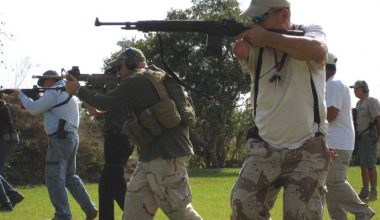 As I write this, it has been just a few days since the horrific shooting in Connecticut, and the gun buying frenzy is in full swing.
As I write this, it has been just a few days since the horrific shooting in Connecticut, and the gun buying frenzy is in full swing.
The anti-gun lobby is, as usual, disrespecting the grieving families and seizing the opportunity to figuratively fling blood in the faces of those of us who choose to protect our Second Amendment rights. Of course the First Amendment allows them to spew their hatred.
Many of us in this country take the well-being of our nation as a thing of personal responsibility and we suffer quietly while the “useful idiots” do the bidding of madmen.
I was on the range on that fateful Friday in December, participating in a Talon Defense Dark Gunfighter course. The other students and I were working on our individual skills when one of the officers in the group said, “There’s been another one at a school in Connecticut.” No one had to ask, “Another what?”
Chase Jenkins, owner and lead instructor of Talon Defense, kept us on task so that news of another massacre of our citizens wouldn’t cast a pall over the class.
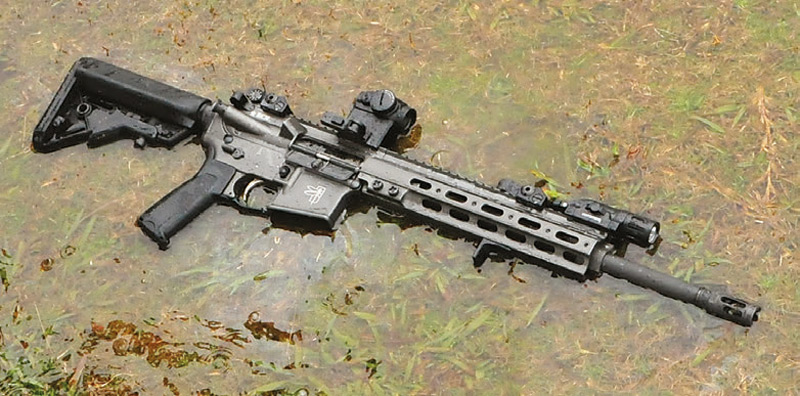
Table of Contents
TRAINING DAY ONE
After the usual meet and greet, we confirmed our zeros at 50 yards and then got right into the training. We first did some static range work to be sure all students were on par. Our class of 21 was made up mostly of law enforcement and military, with a few private citizens. Several industry partners, including G-Code Holsters, High Speed Gear, and SureFire had folks there representing them. Most of us had had some sort of previous training that allowed us to have at least a good working knowledge of our weapons and kit. This allowed the class to get into full swing relatively easily.
Flat range work incorporated our long guns and pistols in various skill-checking drills. Our instructors were Chase Jenkins, Curtis Carpenter, and Greg Brundage. All three men are experienced peace officers and have a large amount of knowledge to impart.
After confirming zero, we took a short meal break to burn off some daylight, then worked well into the afternoon on dot drills, target transitions, hammer pairs, and controlled pairs. Next was the RDS-Down drill (red dot sight broken or out of power). We proceeded with empty reloading drills and weapon transitions. As we finished this set of drills, the sun was dipping down past the horizon. We entered the night with malfunction drills and ground fighting techniques.
Chase and his crew are no slouches. You’ll notice that they saved malfunction drills and ground fighting for true low light. If you don’t know your weapon by feel, you will quickly get into trouble in the dark. Malfunctions in low light have to be dealt with efficiently or you must sling the rifle and use your handgun. Learn your weapons and kit or else you’ll be in serious trouble when the lights go out.

JACK CARBINE
For this class I was running some hardware that I’d gotten from Travis Haley. Travis loaned me his personal Glock with a Skimmer Trigger from Glock Triggers.com. He also loaned me one of the first Jack Carbines to come off the Bravo Company Manufacturing (BCM) production line. I ran them in the same manner I run my own weapons—hard!
I trust the Jack implicitly because I know that Travis and BCM owner Paul Buffoni fully tested the weapon’s design long before it ever got to me. During the three-day class, the Jack was bounced off steel door jambs, rolled around in the mud, and was used and abused far beyond anything that would normally happen to a rifle. I handed it to anyone who wanted to shoot it. I learned to trust the gun and appreciate its simplicity.
Coincidentally, I returned the Jack to Travis at the SHOT Show and it spent the week at the Geissele booth. So if you stopped by their booth and picked up the Jack to check out the ALG Defense ACT Combat Trigger, you were handling the very gun that was run at this class.
In regard to the Glock 17 equipped with Skimmer Trigger, robust pretty much covers it. That trigger ruined me for my stock Glock. I can’t wait to get mine in. It has the ruggedness of a Glock trigger but feels as smooth and crisp as a race gun.
As TD1 came to an end, we took an evening break to make sure it was good and dark. A set of three Viking Tactics-style barriers were set up on the range at the 50-yard mark. We began doing various drills that required us to get hits on steel torso targets. This was not only aggravated by the darkness but was also made that much harder because it was cold and the ground was soaking wet.
Each of us took turns at the barriers and subsequently worked through the newly discovered issues with our equipment. Barrier work is a real wake-up call for your light placement. I knew I would be moving and removing some things on my kit to make low-light fighting more efficient.
Some of us discovered our chest rigs were only designed for fighting while standing or kneeling. As soon as things started turning sideways on us, we were all finding issues with our setups.
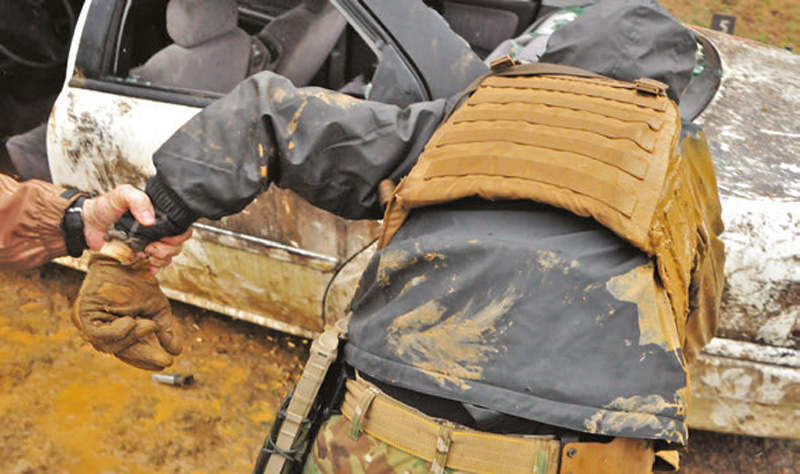
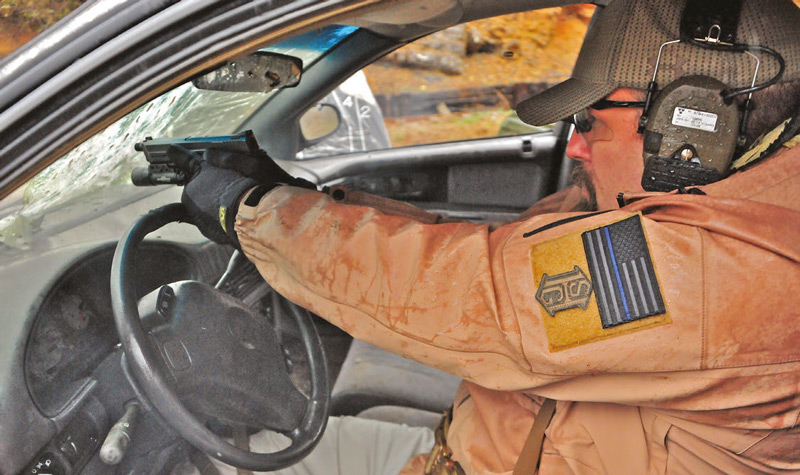
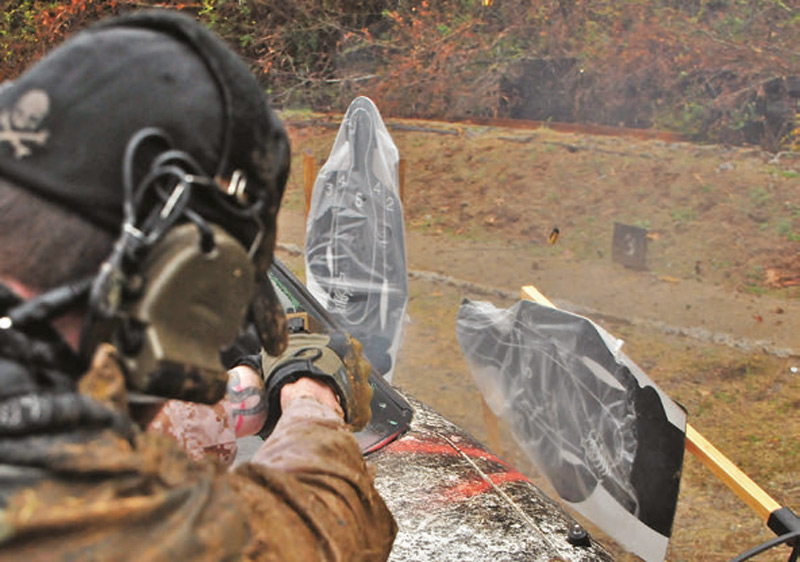
TRAINING DAY TWO
On TD2, we began in the afternoon so the majority of the class would take place in low to no light. We started by doing a modified ground fighting position that yielded far more accurate shots than I thought possible.
Here’s how it works:
Lie down in the fetal position on either side. Take your rifle and lay it across your upper thigh area to stabilize it. Get your eyes behind your optic and press the trigger—yes, it’s that easy.
You’ll have to crane your neck a bit, but don’t worry because it feels natural when you’re doing it from this angle. I appreciated this technique because I had never considered it before, and it’s perfect if you’re injured and unable to move but still have one working hand.
After this drill, we started in on the cars. Oh yes, we tore up some cars at this class!
CAR RALLY
We set up at the 100-yard line and were required to take shots from about five to six positions from the car while using it as cover.
The first was along the back bumper, then over and across the trunk lid. This was known as “junkyard prone”—I love it! Next we went prone under the car. Sometimes we did this once or even twice, depending on how the instructors decided to stack reality on us. Following prone, we went across the hood of the car, then the front bumper. This is where it got interesting for some of us.
What we found was that if we didn’t clear the muzzle, we had wild misses even when we were dead on with our optics. This is due to the fact that the bullet’s trajectory is dramatically altered after it hits anything—even something as soft as a polymer bumper lining. Some of the misses were as dramatic as 20 feet up the berm! That kind of a deviation can cause serious collateral damage.
As evening rolled into night, we got a hardcore lesson in just how ineffective bullets are against car bodies.
We found that pistols in 9mm, .357 Sig, .40, and .45 were rather ineffective at piercing car bodies or glass and maintaining their trajectories. Amazingly, the rifles didn’t fare that much better. We shot 5.56mm, .223, 6.8, .300 Blackout, 7.62mm, and 5.45mm at the glass and the body panels. Not a single one of those rifles was able to put lead on target through the vehicle doors or glass without a severe change of trajectory or the round disintegrating. That was a huge eye opener for us all.
While this is great news for good guys taking cover behind a car, we all need to remember that this works both ways. If the bad guys are taking cover behind a vehicle, you’ll need to wear out their cover and drive them farther back.
We closed out TD2 with some very loud and violent vehicle operations. We set up in two-man teams and worked together to simulate bailing out of cars while under fire. These drills were first done with pistols to show how ineffective our rounds were against windshields, then we transitioned to a fresh vehicle and grabbed our long guns.
As we got into full swing with the rifles, our assumptions about the “power” of a rifle were once again dashed. The sloped safety glass of the windshield kept fracturing our rounds and did little direct damage to the target.


THE TWO-POINT PROBLEM
In conducting vehicle ops, we all discovered that long guns in cars are not easy to fight with, especially if you’re running a two-point sling and have to transition to your support side.
There were a few instances where guys spent too much time fighting their sling or simply didn’t have the rifle slung up until they got out of the car. This pattern is undeniably linked to two-point slings. After spending way too many years fighting my two points, I decided to break rank and go with the sling option that fights better, the single point.
I’ve heard countless instructors say the following phrase: “This is where your single-point sling will really shine.” This is always said during drills where we have to do dynamic movement in confined spaces or around obstacles of varying dimensions or angles. Throw in frequent changes from strong side to support side, and you’ll expend a lot of energy and time fighting your two-point sling.
Single-point slings excel at gunfighting, and the Jack thankfully comes equipped with a rear QD sling plate, so I felt right at home. I run slings from Daniel Basham. He makes them by hand. They are rugged and have never let me down.
TRAINING DAY THREE
On the final day of class, it started raining somewhere around 0400 and by the time we got started in the early afternoon, the entire range was covered with standing water. While the rain was a distraction in our drills, the puddles came in handy for washing our kit off from the rigorous bail-out drills that put us into the mud.
Ground fighting takes on a whole new meaning when you’re cold and wet and mud keeps splashing up into your face and optics.
In one drill, we were required to bail out of the car after engaging an enemy through the windshield. Next we rolled out of the car into the mud. After the third guy, the ground turned into the consistency of oatmeal. All the guys were into this drill and really gave it their all.
At random times, the instructors would punch your shoulder and say, “This arm is out of the fight.” If it were your primary, you would have to switch hands and continue fighting while they physically held your wrist behind your back. In other instances, they would chain the driver’s door and scream, “Your door is pinned, bail out, bail out!” At that point, you had to crawl out a side window or, in a couple of instances, guys went out through the shattered back windshield.
This class was by far the most hardcore I’ve ever attended.
JACK REPORT
The Jack Carbine ran flawlessly except for an incident on the last day of class when an excessive amount of mud was intentionally flung into the chamber by a fellow classmate.
It’s one thing to drop a rifle in the mud to see how some of the silt that might seep into the weapon affects the gun. It’s an entirely different thing to take a handful of chunky Alabama mud and jam it into an open chamber. Not only did it stop up the rifle, it took a serious hosing to get it out.
I made it a point to let everyone know that amount of mud in a gun is not only abnormal, it’s highly unlikely it would get that far into the gun even if the weapon had been fully submerged in the stuff. I take responsibility for this, because students had seen me dropping the gun into muddy puddles of water before going back on the line from a reloading break.
I was actually testing a new lube that Travis wanted some feedback on, and I wanted to see if it would migrate when submerged. My actions led the guys to think I was abusing the gun for kicks and giggles.
I want to state clearly that the Jack had exactly two malfunctions across a three-day, full-on, hardcore class in the elements. Both malfunctions occurred during the “mudding” incident, when a student attempted to run the muddy rifle through a drill. The rifle had not malfunctioned up to that point nor has it malfunctioned since.
After I hosed the rifle out, it was returned to service and the same student ran the Jack without incident.
COMPETITION TIME
The evening finished off with some static range pistol work to burn off the remaining daylight. While on the pistol range, a speed/accuracy competition was held to keep us focused. Then as soon as it was fully dark, it was back out to the cars for more gunfighting.
What I appreciated about this class was that Talon Defense crammed a lot of instruction into three days, with useful drills and spot-on instruction. They also accomplished this without emptying our ammo cans.
At the end of class, the results of the competition were tallied up and various prizes handed out from Jeff Randall, who supplied some ESEE Knives. Scott Wilson of SureFire gave away some goodies as well. Other manufacturers like G-Code Holsters and High Speed Gear, Inc. brought kit for everybody to check out and take home. Every manufacturer supplied each student with discount codes to use for future gear purchases.
CLOSING THOUGHTS
I had such a great time at this class that I intend to return this year for another go-round. There is so much to learn at a class like this that you have to do it twice. The first time, you identify where your shortcomings are. The second allows you to affirm that you made the correct changes.
Many thanks to Chase, Curtis and Greg. I know I speak for the class when I say that you guys are rock-solid instructors.
You don’t get to choose when to have a gunfight—it chooses you. Cold and wet is not how I want to go out, so I’m grateful to know I can fight through the weather and darkness.

